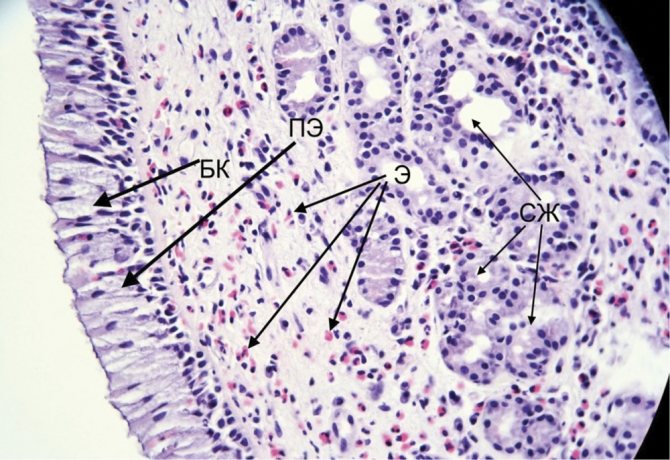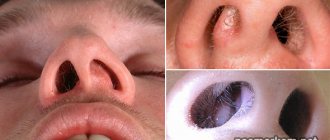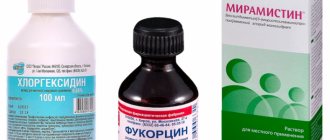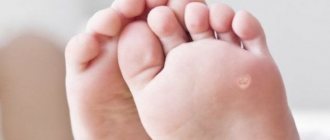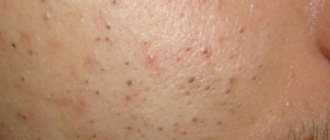How to remove a wart on the nose at home
In real life, warts on the nose cause trouble for many people, regardless of their nature.
Viral tumors are localized on the skin of the nose or the mucous membrane lining the inside of the nose. Three types of warts may appear on the nose:
- Ordinary (has the shape of a nodule);
- Flat (rises flat above the surface of the skin of the nose);
- Thread-like (the growths have the appearance of a thread or, in case of multiple accumulations, they are compared to the comb of a rooster).
Warts on the nose rarely cause pain in patients; the main complaint is a cosmetic defect and the inconvenience of facial care.
Methods for treating and removing papilloma in the nasal cavity
-Papillomas
Papilloma in the nose is a benign tumor that develops from squamous or transitional epithelium and protrudes above its surface in the form of a papilla. This growth is not caused by HPV, but is only superficially similar to the skin manifestation of the virus. Needs examination and removal.
What is and ICD-10 code for inverted papilloma of the nasal cavity
Inverted papilloma of the nasal cavity is an uncommon benign tumor. May spread and grow into the paranasal sinus. According to various sources, it makes up from 0.4 to 4.7% of all entities in this body.
This type of tumor occurs more often in men aged 50-60. Upon examination, you can see a single growth or a multiple family. The color ranges from pink to purple. Due to its location, it becomes inflamed and bleeds.
The increasing size of the formation interferes with breathing and blocks the nostrils. Prone to malignancy.
A malignant tumor develops. Squamous cell carcinoma occurs in 0.2-5% of diseases of the nasal mucosa.
ICD-10 code for intranasal papilloma benign neoplasms: classification D14.0 middle ear, nasal cavity, paranasal sinuses.
Is Schneider's papilloma dangerous?
Schneider's papilloma (oncocytic type) is a rare benign tumor. It grows from the Schneiderian membrane zone. There are endophytic and exophytic types.
Resembles a single growth or gray-pink cauliflower. The leaf-like growths are covered with several layers of oncocytic cells. Internal microcysts with mucus and neutrophils are observed.
Formed on the septum or vestibule of the nose.
Do you need advice from an experienced doctor? Get a doctor's consultation online. Ask your question right now.
Ask a free question
It is observed in patients from 20 to 40 years old. The danger is that relapses often occur. Approximately 1/4 of the formations become malignant. Schneider's papilloma is differentiated from the original form of cancer, especially if frequent relapses occur.
Reasons for appearance
The cause of the tumor, as with all benign tumors, remains unclear.
Factors contributing to the appearance of papillomas in the nose:
- exacerbation of laryngitis and other similar diseases;
- acute respiratory viral infections;
- lack of vitamins;
- unfavorable environment;
- bad habits - damage to the epithelium of the nasal passages when picking with your fingers.
To avoid the appearance of unpleasant growths, monitor your health and avoid all factors of possible infections.
Diagnostic methods
You should contact a dermatologist if symptoms appear:
- Strange dense formation.
- Nasal discharge.
- They began to speak nasally.
- It's bad to breathe through your nostrils.
- Snore.
- Bleeding.
- Pain in the face.
The otorhinolaryngologist examines the mucous membrane and papilloma in a special nasal speculum. To establish an accurate diagnosis, a thorough examination and anamnesis must be performed. The doctor scrupulously asks the patient in what conditions he lives, what preceded the illness, what and when he was sick.
There is a connection with bad habits, professions, and the impact of poor ecology.
Bulletin of Otorhinolaryngology No. 1 for 2020 published the results of a study of patients. 51 people were examined. Of these, 42 were diagnosed with inverted transitional cell papilloma, 9 were diagnosed with cancer risk. The table compares the frequency of clinical manifestations for different diseases.
| Clinical manifestations, signs | Inverted papilloma, % | Nasal cavity cancer, % |
| Difficulty in nasal breathing | 50 | 50,4 |
| Purulent or bloody discharge from one side of the nose | 10,8 | 21,9 |
| Nosebleeds, pus | — | 23,5 |
| Impaired sense of smell | 21,7 | 30,6 |
| Foreign body sensation | 7,2 | 20,5 |
The dermatologist sends for tests. When examining tumor tissue, it is important to find out whether there are malignant cells.
Diagnostic methods:
- radiography;
- rhinoscopy;
- CT;
- MRI;
- histological examination.
A biopsy allows one to distinguish the neoplasm from the initial form of squamous cell carcinoma.
Features of surgical removal
When treating inverted transitional cell papillomas in the nose, the following methods are used:
- Endoscopic surgery.
- Laser ray. Makes it possible to accurately and effectively remove affected cells. The method is used for papillomatosis. The result of the intervention will be the absence of scars. The wound heals quickly. The process is painless.
- Surgitron or radio knife. A device used in radio wave surgery. Removal with a knife does not injure the skin, does not leave scars, and is quick and painless.
The use of methods depends on the localization of the formation.
Wound care after tumor removal
Caring for a wound from papilloma in the nasal cavity depends on the method by which it was removed. After the operation with a radio knife, it is lubricated with a special ointment. A soap solution is used for washing.
The use of a laser promotes the formation of a crust on the wound, which will subsequently fall off. After the operation, they are treated with special ointments. If removed ahead of time, ugly scars will remain.
Regardless of the method, it is important to use vitamins during treatment, carry out antiviral therapy, and increase immunity in order to avoid possible consequences.
Precautions and possible complications
After removal of papillomas in the nose, unpleasant and painful sensations may occur. If anything worries you, consult a doctor. Much of what occurs after surgery will go away over time. After surgery with a laser beam, the patient may experience discomfort in the wound area: strange itching, burning, pain.
Bleeding occurs if the patient takes drugs that reduce blood clotting. You should inform your doctor about this before surgery. An allergic reaction to anesthesia is possible. There are rare complications, but you shouldn’t put off visiting an ENT doctor for help.
It is better to remove formations in specialized clinics or using folk remedies, but after consultation with a doctor.
The article has been reviewed by the site editors Link to the main publication
Didn't find suitable advice?
doctor or see all questions...
articles:
Loading…
Source: https://VashaDerma.ru/papillomy/nosa
Reasons for appearance
The causative agent that causes the appearance of warts on the nose is the human papillomavirus, transmitted by contact and through household objects. This virus has many varieties, some appear in the form of papillomas of different structures and in different parts of the human body.
More than two-thirds of the population is infected with the human papillomavirus, but not everyone is aware of this, since concomitant factors are necessary for the symptoms of the disease to occur.
The main reason for the activation of HPV is a decrease in general or local immunity. This occurs during adolescence, against the background of significant hormonal changes (pregnancy), after infectious diseases, or in the presence of severe chronic diseases (metabolic disorders, AIDS).
Local immunity is easily undermined by improper personal hygiene and frequent trauma to the skin.
These factors reduce local protective properties, provoking the occurrence of neoplasms in people infected with the human papillomavirus.
Diagnostic methods
Only with a comprehensive diagnosis can an accurate diagnosis be made by determining the type of papilloma and the strain of the virus that provoked its appearance. The initial examination of the sinuses is carried out by an otolaryngologist. If there is a suspicion of neoplasms located inside the nasal passages, the following methods are used:
- Rhinoscopy - a small tube with a microscope is inserted into the nasal passages, which allows you to assess the condition of the mucous membrane and the presence of papillomas, their size and other parameters.
- Biopsy - part of the tumor is pinched off and the tissue is examined for the presence of cancer cells, identifying HPV using PCR.
- MRI and CT - prescribed when a biopsy has confirmed the presence of an inverted papilloma, which can easily grow into cartilage and bone tissue.
Rhinoscopy is one of the methods for diagnosing papilloma in the nose
Consultation with an immunologist will be required, since patients with a similar disease have a pathological decrease in interferon synthesis, which requires the use of immunomodulators.
Are warts on the nose dangerous?
New growths on the nose are almost always subjected to physical or chemical influence - they are caught by clothing, a handkerchief, or hands.

The nose gets portions of cosmetics, shaving products, creams.
Any damage to the wart is fraught with the development of complications. Dermatologists often treat inflamed, festering papillomas on the nose. This not only brings discomfort to the patient in the form of pain, but also significantly slows down the healing process.
Tearing off a wart will invariably lead to the appearance of a new one in the same place. And over time, papillomas will multiply and there will be several of them, the number will constantly grow.
Psychological complexes caused by a cosmetic defect worsen the patient’s mood, and the whole body begins to suffer.
The listed points prove the need for competent treatment of warts on the nose.
Removing warts on the nose
For accurate diagnosis and removal of papilloma on the nose, it is important to consult a specialist - a dermatologist or dermatovenerologist. The doctor will be able to make a final diagnosis and choose treatment tactics.
Removing warts using folk remedies
Opponents of medical institutions choose traditional medicine to treat viral papillomas. Over the centuries, peoples have accumulated recipes for getting rid of tumors on the nose.
The most common:
- Treat the wart with fresh celandine juice;
- Use food products for treatment: garlic juice, sour apple, raw potato, vinegar;
- Mix flower honey and freshly squeezed onion juice in equal parts, apply the paste to the papilloma, leaving it overnight.
Drug treatment
Treatment of warts can be carried out by two groups of drugs: those that mummify the growth (Pheresol, Solcoderm) or those that destroy the structure of the papilloma (Cryopharma, iodine, salicylic ointment).
Growth in the nose
The phenomenon of a growth in the nose is far from uncommon. Most often it occurs in people who suffer from chronic rhinitis. Nasal growths occur in men much more often than in women.
To avoid pathologies, growths need to be treated in a timely manner. There are several types of these neoplasms, the most common being the polyp. Only a doctor can make a correct diagnosis, and he also prescribes treatment.
Therapy mainly consists of removing the growths, however, if you detect and begin treatment in time, you can get by with medication. By following all the recommendations that the doctor advises you, the result will not be long in coming.
Drug treatment
Papillomatous growths on the vestibule of the nose do not require complex treatment. A positive effect can be achieved by using agents with a necrotizing effect: cryotherapy drugs, keratolytic ointments.
Local necrotizing drugs:
- Verrucacid. The active ingredients are metacresol and phenol. The medicine has a destructive effect on the focus of the pathology, as a result of which the growths gradually die off.
- Vartek. The basis is podophyllotoxin. The drug has a cytostatic and necrotic effect on lesions. The medicine is prohibited for use by pregnant, lactating women and children.
- Solcoderm. A combined product based on copper nitrate and oxalic, nitric, acetic and lactic acid. The drug cauterizes papillomas, “preserving” the affected tissues, thereby causing their gradual death.
The action of keratolytics is based on the melting of papillomatous growths:
- Salipod - a patch with salicylic acid;
- Kolomak is a drug based on lactic and salicylic acids;
- Lapis is a keratolytic remedy for papillomas and warts in the form of a pencil.
Regular salicylic ointment also has a keratolytic effect.
For patients who are interested in how to get rid of a growth in the nose, the doctor may suggest drug treatment. It will be effective only if the papilloma is located in the vestibule of the organ. Conservative therapy, the effect of which is aimed at removing a benign neoplasm on the face, consists of taking special medications:
- Necrotizing agents (Condilin, Solcoderm, Vartek). They promote the death of affected tissues;
- Keratolytic agents (Lapis, Salipod, Solcoseryl). They make papilloma tissue softer. Thanks to this, the growth is quickly rejected by the body.
Doctors additionally prescribe oxolinic ointment. This drug has a pronounced antiviral effect. It has a positive effect on the immune system and helps it return to normal.
Types of growths in the nose
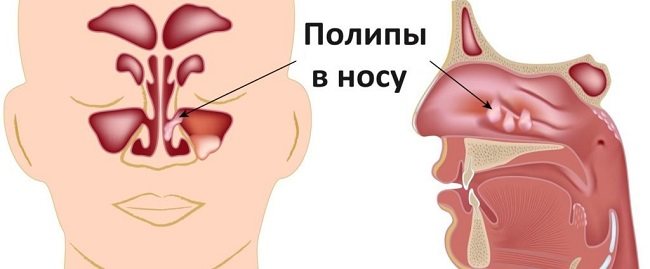
There are several types of growths in the nose:
- Cone
- Hematoma of the nasal septum
- Polyps
- White seals
- Basalioma
- Thorn
- Cancer
Cone
A bump on the septum is a small lump that can cause pain, difficulty breathing, and just plain discomfort. This disease is quite common and occurs in both men and women. A lump is formed due to the influence of the following factors on the body:
- Weakening of the immune status.
- Chronic pathological processes in the nasal cavity.
- Septal defects.
- Violation of the integrity of the mucous membrane.
- Presence of adenoids.
- Poor nasal hygiene.
In addition to the listed risk factors, some diseases can contribute to the appearance of bumps on the septum:
- A furuncle is a purulent pathology that primarily affects the hair follicles. Foci of localization can be in any part of the nasal mucosa. It is characterized by the appearance of a compaction that is painful to the touch. When opening a purulent formation inside the nose, complications are possible, including sepsis.
- Polyps are benign neoplasms that arise due to frequent colds, due to changes in the structures of the nasal mucosa. Mainly localized on the septum.
- Malignant neoplasm can also cause a bump on the nasal septum. Characterized by difficulty breathing, pain, bleeding, headaches.
- Glioma is a benign tumor that can be congenital. Gradually increases in size, causing characteristic symptoms and is eliminated with surgery.
- Atheroma is a small bump on the septum, formed due to blockage of the sebaceous ducts.
- Hemangioma, angioma, lymphangioma are benign neoplasms caused by frequent and abundant mucus secretions.
- Papilloma is a dangerous viral pathology, characterized by numerous development of bumps on the septum. It has dangerous complications, so treatment must be timely.
- An adenoma is a benign tumor that grows slowly and is eliminated with surgery.
Consequences
In the absence of timely diagnosis and treatment, papillomas in the nasal cavity can:
- invert into a chronic focus of inflammation;
- grow on adjacent organs or tissues - larynx, pharynx, esophagus;
- be a favorable environment for various infections;
- interfere with normal nasal breathing, significantly impairing quality of life;
- invert into a cancerous tumor.
Having discovered phenomena in the nose that are atypical for this organ, even despite the possible absence of symptoms, it is necessary to contact an otolaryngologist - this will help solve the problem at the initial stage and prevent the development of unpleasant and dangerous consequences.
- Removal of keratomas on the face in the El.N Beauty Club salon
Lump on the nose
- 3 minutes to read

A lump on a person’s nose is an acquired type of neoplasm, which may indicate some kind of disorder occurring in the body. Such compaction leads to a deterioration in appearance and may be accompanied by discomfort and inconvenience. Since a growth may indicate the development of a benign or malignant process, you need to know what symptoms and external signs manifest a particular disease.
Content
What could it be
A bump on the nose often indicates some pathological process. Experts identify several types of neoplasms that can manifest themselves in this way.
Hemangioma
This is a benign neoplasm formed from capillaries and blood vessels. The growth does not cause pain. The skin in the affected area is bluish or reddish.
Treatment of the pathology does not present any difficulties. In rare cases, malignancy of the pathological process is noted.
Wen
This is a formation consisting of growing subcutaneous adipose tissue. In appearance it resembles atheroma, but in this case the site of its localization does not swell and is not accompanied by pain.
Wen, as a rule, is small in size and easily amenable to therapeutic manipulation.
Atheroma
This is a lump on the skin caused by blockage of the sebaceous glands. In appearance, the neoplasm is presented in the form of a lump with clearly defined contours.
As a rule, atheroma is elastic and painless when palpated. If an inflammatory process begins to develop, the patient complains of discomfort and suppuration at the site of the lesion.
Surgery to remove papillomas
There are several types of removal of benign tumors. Before choosing one of the methods, the ENT doctor prescribes the patient to undergo a series of tests, which include:
- General urine analysis.
- General blood analysis.
- Polymerase chain reaction for DNA virus.
- Biopsy of a piece of papilloma to a bacteriological laboratory.
- Histological examination of the location of the tumor.
Having received the research results, the patient is sent with them for a second consultation with an ENT doctor. The specialist chooses a surgical treatment method that helps get rid of the benign tumor.
Modern medicine helps remove papilloma in the nasal passages quickly and effectively. The procedure is painless with minimal or no bleeding.
Methods for removing benign tumors:
- Using laser equipment.
- Using radio waves.
- Application of liquid nitrogen.
When the papilloma is exposed to cold, heat or steam, the active cells of the neoplasm die. What remains is dead tissue, which falls off by being rejected by a healthy area of the mucous membrane or skin.
Surgical intervention in the form of excision of papilloma with a scalpel or using current is used extremely rarely in modern medicine. The procedures take longer and the patient must be given general anesthesia. The methods are not anemic; complications may arise when performing them. The rehabilitation period increases. The procedures are almost impossible for children to perform.
Despite the choice of surgical intervention, the ENT doctor prescribes medications that help improve the immune system during rehabilitation and to prevent complications and relapses.
Laser
- Removal of papillomas using laser equipment is carried out in medical institutions by an ENT doctor. Before the procedure, the specialist prescribes the patient to undergo clinical tests, collects an oral history and takes into account the individual characteristics of the disease. Laser removal of tumors is carried out when they are localized at the beginning of the nasal passage, where the beam of a medical device can reach. The surgical intervention takes no longer than 20 minutes. The laser beam burns the papilloma, and it is rejected. No nosebleeds occur after the procedure. The rehabilitation period is short, with full compliance with medication intake. During the surgical procedure, the patient smells a burning smell from the cauterization of the tumor. An ENT doctor does not prescribe laser removal of papillomas if their growth is extensive.
- In medicine, there is a second way to remove papilloma in the nasal passage using a laser beam. The ENT doctor places a loop made of metal similar to a guitar string around the tumor. Pulls it up at the base of the papilloma and cuts off the growth. After removal, the tumor is sent for histological examination, and the localization site is treated with a laser beam. The device helps stop bleeding and prevents bacteria from attaching.
Cryodestruction of papilloma
This method is popular when removing tumors inside the nasal passages and on the nose. During the procedure, the papilloma is exposed to low temperatures. The new growth is “frozen” with liquid nitrogen at a low boiling point of 196 degrees Celsius. Removal of papillomas using cryodestruction is carried out when the growth has a root that must be removed in order to prevent relapse.
Read more Serous cystadenofibroma of the ovary
The procedure has a number of contraindications:
- When diagnostics revealed high rates of papilloma developing into a malignant neoplasm.
- If the patient has an allergic reaction to liquid nitrogen.
- When the patient has acute inflammatory processes in the body at the time of the procedure.
- Presence of diabetes mellitus.
Cryodestruction can be performed on pregnant women and children. The procedure is performed without bleeding or pain. When a papilloma on the nose is removed, a small scar in the form of a dot may remain on the skin. The manipulation is not carried out on the scalp, since under the influence of nitrogen the hair follicles may die and bald spots may form.
Cryodestruction is performed on an outpatient basis in a hospital or private clinic. The specialist places gauze napkins around the papilloma. Applies the sensor with nitrogen to the papilloma in three stages. The first is the shortest, up to fifteen seconds. The total impact on the papilloma with nitrogen is no more than two minutes. The area of skin becomes noticeably white and hard. The next day, dropsy appears at the site of the neoplasm, which bursts and forms a dense crust, which disappears on its own within a month. Once the scab is shed, new pink skin is produced.
For two months after cryodestruction, the patient is prohibited from sunbathing or visiting places with temperature changes. Women are not recommended to wear decorative cosmetics.
Electrocoagulation with cold current
Removal of papillomas using the electrocoagulation method is carried out in public hospitals and private clinics equipped with specialized medical devices. “Suriton” is the most famous and popular technique. Influencing the papilloma, the current, using cold influence, instantly cuts off the neoplasm from the nasal mucosa. The vessels undergo coagulation, during which they do not release blood. The advantages of removing papillomas in the nasal passages using the Suriton medical device are:
- Prevention of secondary infection.
- Short rehabilitation period.
- The procedure does not cause pain in the patient.
- The device, which affects the mucous membrane, does not leave scars.
Using an endoscope
Endoscopic removal of papillomas in the nasal passages is most often performed. This method of surgical intervention helps to eliminate the tumor, regardless of its location, in the vestibule of the nasal passages or in the depths of the nose. An ENT doctor performs an operation using a surgical endoscope equipped with an eyepiece and a flexible tube with a camera and a light at the end.
The operation is carried out under the full control of a specialist thanks to the image displayed on the monitor. The rehabilitation period is short. If you keep visiting your doctor and take medications, the formation of a relapse is reduced to zero.
Open surgery
It is carried out by an ENT doctor in a medical institution according to individual indications and the presence of extensive neoplasms. During the surgical procedure, the patient is given general anesthesia by injection, and a specialist opens the nasal cavity. Papillomas are removed with a scalpel along with their location. After treatment, the nasal cavity is sutured. Gauze turundas moistened with hydrogen peroxide are inserted into the passages.
After the operation, the patient continues to have nosebleeds for a long time. The rehabilitation period is long and painful. The patient is in the hospital for at least 10 days after the surgical procedure.
Could it be cancer?
If a lump appears on the tip of the nose, this does not always indicate the development of a benign formation. Under certain conditions, such a lump may indicate the presence of an oncological process.
Basalioma
Externally, such manifestations are pustular lesions. Such tumors are also dangerous and require surgery.
Melanoma
They are growths that form from moles. Such seals are classified as cancerous. Therefore, at the first suspicion, a qualified examination and immediate therapeutic measures are required.
Fibrosarcoma and liposarcoma
Characterized by damage to the skin and adipose tissue. It has an infectious nature of origin and manifests itself in the form of a growth.
The tumor is predisposed to slow growth and, compared to other oncological pathologies, is less dangerous to human health. However, it is under no circumstances recommended to leave it unattended.
Diagnostics
External nasal papilloma is easily visualized and to examine it, it is enough to carry out:
- Rhinoscopy.
- Biopsy with histology.
- Taking urine and blood tests.
When the affected area is in the nasal passages or sinuses, the following is required:
- Inspection using dilators.
- X-ray. The pathological area will be darkened.
- CT or MRI. Provides information about the size of the tumor and the condition of nearby tissues.
- Histology. Helps identify malignant neoplasms and the tendency of benign tumors to degenerate.
